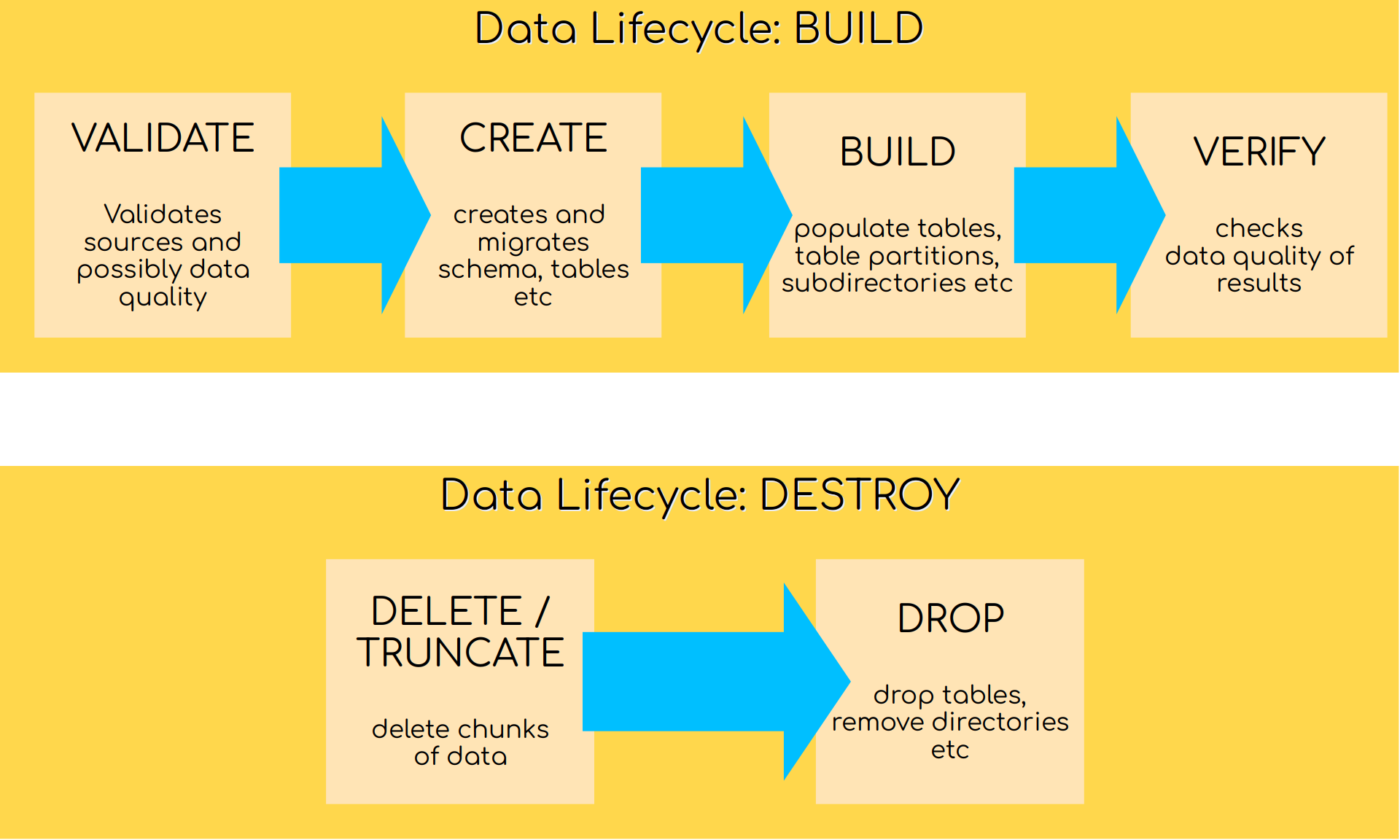Lifecycles and Phases#
Flowman sees data as artifacts with a common lifecycle, from creation until deletion. The lifecycle itself consists of multiple different phases, each of them representing one stage of the whole lifecycle.

Execution Phases#
The full lifecycle consists out of specific execution phases, as follows:
VALIDATE. This first phase is used for validation and any error will stop the next steps. A validation step might for example check preconditions on data sources which are a hard requirement.
CREATE. This will create all relations (tables and directories) specified as targets. The tables will not contain any data, they only provide an empty hull. If a target already exists, a migration will be started instead. This will migrate a relation (table or directory) to a new schema, if required. Note that this is not supported by all target types, and even if a target supports migration in general, it may not be possible due to not migratable changes.
BUILD. The build phase will actually create all records and fill them into the specified relations.
VERIFY. The verify phase will perform simple checks (for example if a specific Hive partition exists), or may also include some specific user defined tests that compare data. If verification fails, the build process stops.
TRUNCATE. Truncate is the first of two phases responsible for cleanup. Truncate will only remove individual partitions from tables (i.e. it will delete data), but it will keep tables alive.
DESTROY. The final phase destroy is used to physically remove relations including their data. This will also remove table definitions, views and directories. It performs the opposite operation than the CREATE phase.
Built In Lifecycles#
Some execution phases can be performed in a meaningful way one after the other. Such a sequence of phases is called lifecycle. Flowman has the following lifecycles built in:
Build#
The first lifecycle contains the three phases VALIDATE, CREATE, BUILD and VERIFY.
Truncate#
The second lifecycle contains only the single phase TRUNCATE
Destroy#
The last lifecycle contains only the single phase DESTROY
Targets & Lifecycles#
Each target supports a certain subset of execution phases. Not all targets support all
phases. For example, the widely used relation target which is used for creating data
sinks and for writing new data into them supports the phases CREATE, BUILD, VERIFY, TRUNCATE and DESTROY. On
the other hand, the measure target which collects some data dependent metrics is only
executed during the VERIFY phase.
Of course, when a specific target participates in multiple execution phases, it will perform different actions in each of the phases. The documentation of each target will contain the details of the supported phases and what action is performed in each of them.
Jobs & Lifecycles#
A job groups multiple targets to a logical bundle, which should be built together. When executing a lifecycle for a job, Flowman will apply the following logic:
Interpolate any given parameter given on the command line, for example
flowexec job daily verify processing_date:start=2022-11-01 processing_date:end=2022-11-10would cycle through 10 consecutive days and execute the jobdailywith the parameterprocessing_dateset accordingly.Iterate over all execution phases of the lifecycle (i.e. VALIDATE, CREATE, BUILD, VERIFY).
Perform dependency analysis of all targets within the job, which are active for the current execution phase
Identify all active targets in the current phase (possibly accordingly to the jobs
executionssection)Check each target if it is dirty (i.e. it requires an execution) the current phase
Execute all active and dirty targets in the correct order
Dirtiness#
Before executing a target, Flowman checks if the target is actually dirty, i.e. if it is outdated. Typical examples
are a schema change in the CREATE phase, or a new data partition in the BUILD phase. Some details of this logic
can be influenced via the buildPolicy setting in the relation target
or via the Flowman config flowman.default.target.buildPolicy. Possible values are
ALWAYS: The target is always considered to be dirty.IF_EMPTY: The target is considered to be dirty, if the specified target partition does not exist (or is empty).IF_TAINTED: The target is considered to be dirty, only if it is tainted by a dirty dependency.SMART: The target is considered to be dirty, if the target partition is empty, or when the output mode is set toAPPENDor when no partition is specified (full overwrite)COMPAT: The target is considered to be dirty, if the target is empty, or when the output mode is set toAPPEND. This setting provides the same behavior as Flowman before version 0.30.0. The exact details always depend on the specific type of the target.
Note that Flowman also cascades dirtiness during the execution. This means that if target B depends on target A, and target A is dirty (because data is overwritten), then target B also becomes implicitly dirty via its dependency.